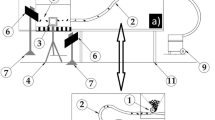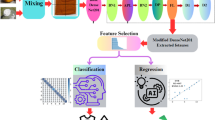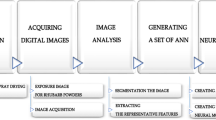Abstract
This study utilized a unique neural network model for texture image analysis to differentiate the crystallograms from pairs of fresh red pepper fruits from conventional and organic farms. The differences in visually analyzed samples are defined as the distribution of crystals on the circular glass underlay, the thin or thick structure of crystal needles, the angles between branches and side needles, etc. However, the visual description and definition of bio-crystallogram images has major disadvantages. A novel methodology called an image neural network (INN) has been developed to overcome these shortcomings. The 1,488 × 2,240 pixel bio-crystallogram images were acquired in a lab and cropped to 425 × 1,025 pixel images. These depicted either a conventional sweet red pepper or an organic sweet red pepper. A set of 19 images was utilized to train the image neural network. A new set of 4 images was then prepared to test the INN performance. Overall, the INN achieved an average recognition performance of 100 %. This high level of recognition suggests that the INN is a promising method for the discrimination of bio-crystallogram images. In addition, Hinton diagrams were utilized to display the optimality of the INN weights.









Similar content being viewed by others
References
Harms W (2004) Quality of organic food. Genet Eng Newslett (Special Issue) 16:1–11
Pfeiffer E (1931) Studium von Formkr¨aften an Kristallizationen. Naturwissenschaftliche Sektion am Goetheanum, Dornach, Switzerland
Engqvist M (1970) Gestaltkrafte des Lebendigen. Klostermann, Frankfurt amMain, Germany
Bloksma J, Northolt M, Huber M (2001) Parameters for apple quality part-1. Louis Bolk Institute, p 115 (Archieved at http://orgprint.org/4266)
Andersen JO, Henriksen CB, Laursen J, Nielsen AA (1999) Computerised image analysis of biocrystallograms originating from agricultural products. Comput Electron Agric 22(1):51–69
Meelursarn A (2006) Statistical evaluation of texture analysis from the biocrystallization method: effect of image parameters to differentiate samples from different farming systems, submitted in fulfillment for the degree of doctor of agricultural science. University of Kassel, Department of Organic Food Quality and Food Culture, Witzenhausen, December 2006, p 220
Kuşçu A (2008) Organik ve Konvansiyonel Kırmızıbiber ve Ürünlerinin Ayırt Edilebilme Yöntemleri ve Kalite Özelliklerinin İncelenmesi. Ege Üniversitesi Fen Bilimleri Enstitüsü, Ph.D. Thesis, 420 p, Izmir
Doesburg P, Huber M (2007) Biocrystallisation and Steigbild results at the Louis Bolk Instituut. Elemente Der Naturwissenschaft 87:118–123
Balzer-Graf UR, Köpke U, Geier U (2001) Research on quality in organic agriculture by picture forming methods, understanding the quality of organic horticultural products (Short Course on). 15–26 May, Izmir, Turkey
Szulc M, Cordeiro F, Maquet A, Anklam E (2005) Application of a multivariate design approach for maximisation of the observed differences between organically and conventionally grown wheat grains in biocrystallisation method. In: Proceedings of the 1st scientific FQH conference, November 28th & 29th, Fibl, Frick, p 78
Timothy Masters (1993) Practical neural networks. Academic Press Inc., Waltham, Massachusetts
Kendall MG, Stuart A (1963) The advanced theory of statistics. Charles Griffin & Company Limited, London
Cichocki A, Unbehauen R (1992) Neural networks for optimization and signal processing. Wiley, Hoboken
Freeman JA, Skapura DM (1991) Neural networks algorithms, applications, and programming techniques. Addison-Wesley Publishing Company, Boston
Rumelhart DE, Hinton GE, Williams RJ (1986) Learning representations by backpropagation error. Nature 323:533–536
Hollis PW, Paulos JJ (1988) Artificial neural networks using MOS analog multipliers. In: International conference on neural networks
Hollis PW, Paulos JJ (1994) A neural network learning algorithm tailored for VLSI implementation. In: IEEE transactions on neural networks, vol. 5, No. 5
Author information
Authors and Affiliations
Corresponding author
Rights and permissions
About this article
Cite this article
Unluturk, S., Unluturk, M.S., Pazir, F. et al. Discrimination of bio-crystallogram images using neural networks. Neural Comput & Applic 24, 1221–1228 (2014). https://doi.org/10.1007/s00521-013-1346-6
Received:
Accepted:
Published:
Issue Date:
DOI: https://doi.org/10.1007/s00521-013-1346-6




